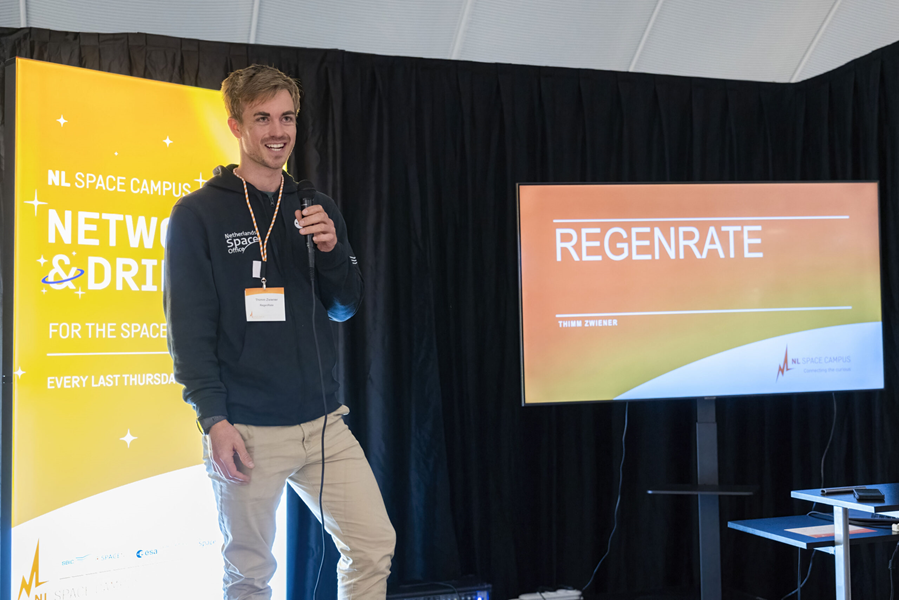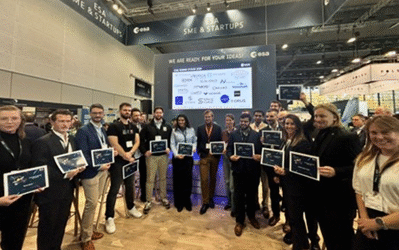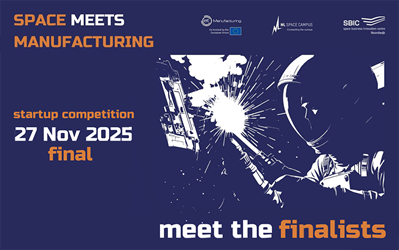ESA BIC incubatee RegenRate is scaling certified, intermediary crops for the sustainable aviation fuel industry. Traceability is key – from soil to the sky. At the core of its offering, the startup’s software platform leverages satellite data meaning biofuel producers can source sustainable feedstock that complies with European regulations. The team works with farmers to turn a cover crop – camelina – from what has previously been a cost to be a revenue-making opportunity thanks to the startup’s tech. Read on to discover more from Alice Henry, the CEO of RegenRate.

Maybe you’ve seen a sunshine-hued crop carpeting fields in the countryside throughout the year and assumed it was rapeseed but maybe it was another Brassicaceae plant. Camelina sativa – the oilseed crop that is of interest to RegenRate – has pale yellow petals, can be grown in summer or winter, and has seeds suitable for applications in various industries. While the startup’s harvest will fuel sustainable aviation, the initial focus on the ground is for the team to work directly with farmers – and a vital task is sharing the key message that camelina is a crop that’s both profitable and resilient in the field.
This approach has materialised after an early pivot in the plan. RegenRate was founded by Alice Henry (CEO) and Thimm Zweiner (CTO) in July 2022 and began incubation at ESA BIC Noordwijk in October 2024. The aim is to become a bridge between regenerative agriculture and sustainable aviation. The startup’s tech solution is a platform incorporates space data and ensures traceability for the raw materials. No certification means no business model. So, RegenRate is innovating in regenerative agriculture with satellite imagery for the production of cleaner aviation fuel. Earlier this year, the team was out and about getting the message across at various events, including at the International Agricultural Show in Paris, Soil Health Now in Wageningen and Regenerative Food Systems Investment (RFSI) conference in Brussels, where RegenRate won the best pitch competition. On the back of this comes the news that a milestone was reached this month: 1000 hectares of camelina have been planted as the intermediary crop for over 50 farmers who have partnered with RegenRate! Alice explains more about the journey below.
What is the mission of RegenRate?
We are scaling certified, intermediary crops for the sustainable aviation fuel industry (SAF). So, we work with farmers to grow our camelina crop on fields when nothing else is growing and we unlock the environmental and economic potential of cover crops by transforming them into a viable source of income for farmers.
Why choose camelina as a cover crop and why is it your focus?
Firstly, it has a short growth season. Secondly, it has very few needs and is what we call a low-input crop. It doesn’t require a lot of fertilisation – and depending on the crop you had before, it might not even need any. Then, you just let it grow. It’s great because it attracts pollinators (which can increase seed yield), it cleans the field and you have a much healthier soil for the next crop. The advantage for the farmers of a cover crop – a crop you put between two seasons, also known as an intermediary crop – is that it enhances the soil by removing pests and adding organic matter. So, biomass will return to the soil and give diversity, attracting bees early on in the season.
Where we come in is that, traditionally, cover crops have been a cost to farmers. Our idea is to make it a revenue-making opportunity in the future – for the farmers – because we want them to grow the crop so that we can then harvest the seeds and use these as fuel for a cleaner aviation sector.
What problem is your solution addressing?
There are two factors, whether we are considering the aviation or the agricultural focus. The commercial problem we’re solving is access to raw materials (feedstock) that is scalable in the future, which is an urgent problem for the aviation industry. What you can and can’t use for SAF is highly regulated. The problem is the stable access to those sources of supply in the future. Right now, we’re kind of at a market balance where there is more or less enough of raw materials to be transformed into SAF. The balance is expected to shift as we approach 2030 as new laws are introduced aimed at reducing aviation emissions.
The current mandate is 2% of SAF at the airport and this is shifting to 6% by 2030. But, the question is how we drive growth to meet that demand. At the moment, there is no feedstock that is sufficient as we move towards 70% by 2050. For now, there are two key feedstocks – used cooking oil and animal fats – and these are not scalable to produce the quantities required. As the mandates for airlines to use SAF grows, new raw materials are needed. The European Commission is working on the transition towards advanced biofuels made from sustainable feedstock and highlights that current raw materials are insufficient. Our solution using camelina will provide additional sustainable feedstock volumes.
What is your approach?
It is a kind-of marketplace: We need the suppliers and the customers. So, we have a value position for the fuel industry and we have a value proposition for farmers. We know the fuel suppliers for the aviation industry (the customers) need a new and sustainable source of oil. So now, we need to convince farmers to do something new and grow camelina as a cover crop. Even if there is money in it for them, you’re convincing them to do something that is a new practice for them. Something that may help to convince the farmers to adopt this new idea of growing a cover crop is a highly-incentivised common agricultural policy (CAP). We already have really high success rates for converting farmers to camelina who are already growing a cover or intermediary crop.
What is the main challenge?
Agriculture can be a risky business. One year the climatic condition for your crop are amazing and you’re not having a terrific return, which is great. But you are at the mercy of the weather.

Sustainable farming practices: Camelina is an advantageous choice for farmers seeking profitable, sustainable and resilient agricultural options, especially in dryland and challenging climates. Its deep root system prevents erosion while adding organic matter making the soil more fertile and can enhance soil health within crop rotations. No new equipment investments are required for growing it and the RegenRate team harvest directly from the farm’s locality and turn it into sustainable aviation fuel. grow.regenrate.com
What is the background to the company?
We started out working on a different product. We were giving advice to farmers on how to do cover cropping, helping them farm more sustainably and efficiently. We were building context using our platform – with remote sensing, satellite imagery, algorithmic models and artificial intelligence (AI) – and we’d send tailored advice directly to their phones via WhatsApp. But there was a big problem as it turned out that most farmers weren’t implementing the advice. Not because they didn’t care, but because they didn’t know when there’d be a real return on investment. Cover crops meant extra work and cost, with no immediate payoff. And without that return, they weren’t ready to pay for our product either. That was our first big lesson: the cover cropping wasn’t the problem, the business model was. Our steward-owned company has always been looking at scaling cover cropping and our core mission is to scale regenerative agricultural practice one way or another with farmers.
At the same time, we had an oil and gas company that was using our backend (the remote sensing part) to see which seasons the feedstock that they were producing was growing when we started to get curious about what was happening and why they needed this data. It turns out, they were using our satellite tools to verify if their biofuel feedstock crops were compliant – specifically, there were regulations which meant they had to prove the crops didn’t compete with food and were grown in off-seasons. We initially tried to sell them software showing that for all their crops but they had a need for the feedstock and not the data. They wanted access to certified, compliant crops but couldn’t convince farmers to grow them. That’s when we had a lightbulb moment: what if we grew the feedstock for them? We already had the farmer relationships, the agronomic guidance product and the tech systems with the measurements based on space data. So, instead of selling software to the oil/gas (aviation) companies, we started selling certified oil – and things moved fast from there. All of a sudden, the sales cycle became a lot shorter and they were a lot more responsive.
Producing certified feedstock is at the core of what we do – our platform with the satellite imagery data is the backbone of the certification process
alice henry
How did you validate the current business model?
We first ran initial pilots and are now running pre-commercial scale in Belgium, Croatia, France, Hungary, Netherlands, Portugal and Spain with our camelina programme. Our team out in the field – led by Elise Leflour – has been getting commitment from farmers. We recently announced that we have reached a milestone of over 60 farms with 1200+ hectares now seeded for the cropping season, which will see us reaching our target to produce 1000 tonnes of raw materials this year. We’ll then get busy creating oil and selling our certified feedstock.
What is the space link that your solution relies on?
We need traceability and, so basically, this feedstock without the certification is worthless. Satellite data is essential – it’s how we certify the feedstock. To be allowed, a feedstock must meet a few key rules: it can’t come from land that was recently forests, wetlands or nature reserves; it shouldn’t replace food or feed crops; it should help reduce emissions compared to fossil fuels; and it must be traceable and certified to prove it meets these standards. We use satellite imagery to: track where and when camelina is grown; prove it’s cultivated in fallow or off-season periods; measure emission reduction; and ensure no land-use change has occurred.
This is at the core of what we do – and we are unique in this. Our platform with the satellite imagery data will be the backbone of the certification process: it allows us to check eligibility according to the sustainability standards; it enables us to follow the season and how well the crops are doing remotely, prepare follow up meetings; and it simplifies certification. This is where the farmers upload their documentation to be checked and then the oil and gas customers will use it to see where the feedstock is coming from.
What are you focusing on during incubation?
We are busy building the platform right now and incorporating the satellite data into it. We already had our minimum viable product (MVP) when we joined ESA BIC – it was built in the earlier stages of our journey. During incubation, our focus is to scale and harden the platform, making it robust enough to support 500 farms next year and eventually many more.
By the end of the programme, we’ll have a powerful software system that can track certified feedstock, parcel by parcel, batch by batch. Each bag of seeds will come with its own story: where it was grown, how much carbon dioxide was produced during the process, and how it complies with EU regulations for sustainable fuel.
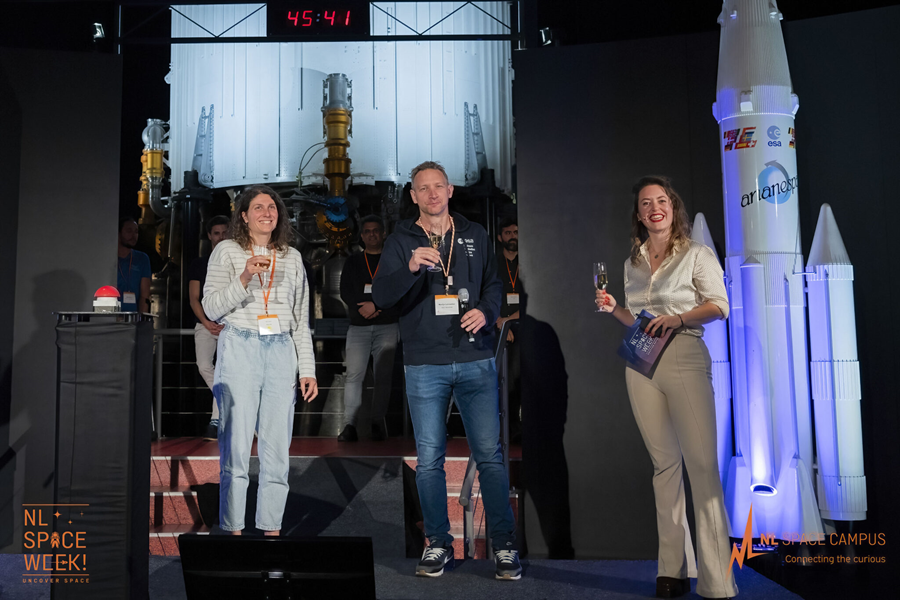
What stage are you currently and what hurdles are you facing?
We now have team members working on the front and back end of the platform. The challenge we’re facing now is technical and regulatory. On the tech side, we’re trying to build functionality that recognises exactly when crops are growing, identifies the crop cycle or any flagging growth issues – for all of which cloud coverage is an issue.. There are so many variables, like making the agronomy work and weather events, that can impact production. We are also adapting to the local requirements. Since we’re working across six countries now (and adding another three soon), adapting the platform to each local regulation adds a whole new layer of complexity.
Of course, we need to work across that many regions because of the scale we need to reach. We have to produce 15,000 tonnes of certified feedstock to meet minimum order volumes for just one serious customer – and ideally, we want to reach 60,000 tonnes in the next couple of years. So, we are working with partners with farms in different countries and we see that once you have a hub in a certain country, they are organic growth points.
Are you seeking investment at this stage?
Yes, we have raised a small round and we’re going to raise another round at the end of the year. I would say we are more or less settled for the first initial phase where I can prove that we can deliver small volumes of certified oil product to a first client. And then we will raise for doing this at scale.
What drew you to participate in ESA BIC?
I’m from the AI industry and first worked in San Francisco for a data annotation and model evaluation company before I came back to open their branch in Europe. That’s when I decide to start my own company and met Thimm who is an AI engineer specialised in remote sensing. His training is in satellite imagery and machine learning, so one way or the other, ESA was always an interest. After I participated in various early-stage programmes, such as Fresh Ventures, StartLife and (with my previous venture) the accelerator for women-led startups GreenTech Europe, we were then drawn to ESA BIC. When you’re working with satellite data, you know ESA is important. So, we tried a few things – applying to tenders, etc. – and then we applied for the incubation programme as we felt it would be a good fit. For our certification software, Thimm was developing everything alone and the prospect of having other people to brainstorm with was really appealing.
Get financial support (€60K funding) to help launch your space business >>
What aspects of the ESA BIC programme are you enjoying?
I think we have already benefited a lot from being with the other incubatees. We’ve been discussing challenges and we’ve found some solutions thanks to that. We’re now also recruiting and we’re already speaking to a few people through the network. For me, it is the community that I value the most. The programme itself is great with the training courses and we have our first coach and we’ve have had good meetings. For me, it’s aways the people in the community that are important – I love having the opportunities for debating things and discussing big issues – such as cloud coverage in agriculture. We are not integrating the radar data as yet and at a certain moment we will for sure. For now, our MVP does not need it and we are all about getting that first certification.
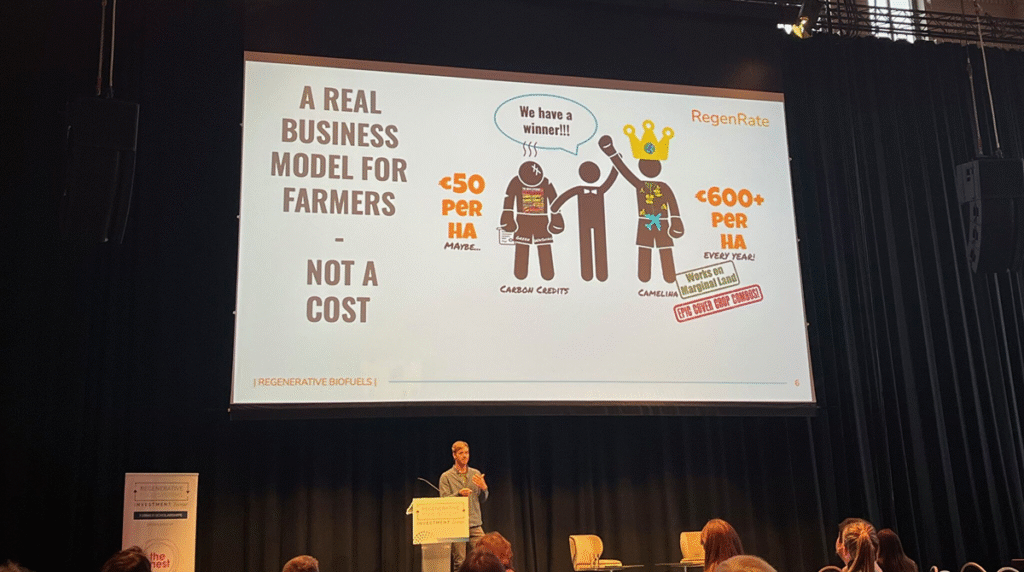
Any encouragement for anyone – including female founders – to apply to ESA BIC Noordwijk?
For me, it comes down to the community, which is something that ESA BIC definitely delivers on. I really recommend anyone to apply and benefit from being surrounded by like-minded people as you build your business. It would be great to see more female-led startups in the programme. Maybe its to do with awareness and timing. So, more than scouting for tech ventures that have already been created by females, get to those people who are wondering about the prospect of starting something. By making it clear that there is support from ESA available at the get-go, we can engage them at the ideas stage – through hackathons for instance – so they then can get inspired to develop that idea into a space startup.
It would be great to not be so often the only female on the line-up for conferences that I go to, as the agriculture sector is also male dominated. Let’s change that. I’m a big supporter of the fact that teams and communities do benefit from diversity.
And any final words on what you find interesting about space?
My favourite thing about space is that it feels like everything is possible. How the explorers of the what 12th century felt about the Earth is how I feel that about space. There is just so much out there we don’t know about. It’s the dream I guess, the fact that everything can be possible out there!
ABOUT REGENRATE
RegenRate is a steward-owned company building scalable, market-driven solutions for regenerative agriculture. Founded in 2023, RegenRate helps unlock the environmental and economic potential of cover crops by transforming them into a viable source of income for farmers. The company focuses on intermediary crop systems that improve soil health, support biodiversity, and generate sustainable biomass for the SAF (sustainable aviation fuel) sector. It currently develops camelina as feedstock in 10 countries of Europe. RegenRate enables greenhouse gas emission reductions in compliance with EU regulations, while supporting a resilient agricultural transition across Europe. regenrate.com
Validate your business plan and space connection!
Refine and validate your space business idea via the space connection assessment takes place as part of your preparation of applying to ESA BIC. Want to find out more? Meet the team & get your questions answered:

